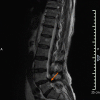Severe lumbar spinal stenosis combined with Guillain-Barré syndrome: A case report
- PMID: 33644172
- PMCID: PMC7896650
- DOI: 10.12998/wjcc.v9.i5.1096
Severe lumbar spinal stenosis combined with Guillain-Barré syndrome: A case report
Abstract
Background: Guillain-Barré syndrome (GBS) is a rare disorder that typically presents with ascending weakness, pain, paraesthesias, and numbness, which mimic the findings in lumbar spinal stenosis. Here, we report a case of severe lumbar spinal stenosis combined with GBS.
Case summary: A 70-year-old man with a history of lumbar spinal stenosis presented to our emergency department with severe lower back pain and lower extremity numbness. Magnetic resonance imaging confirmed the diagnosis of severe lumbar spinal stenosis. However, his symptoms did not improve postoperatively and he developed dysphagia and upper extremity numbness. An electromyogram was performed. Based on his symptoms, physical examination, and electromyogram, he was diagnosed with GBS. After 5 d of intravenous immunoglobulin (0.4 g/kg/d for 5 d) therapy, he gained 4/5 of strength in his upper and lower extremities and denied paraesthesias. He had regained 5/5 of strength in his extremities when he was discharged and had no symptoms during follow-up.
Conclusion: GBS should be considered in the differential diagnosis of spinal disorder, even though magnetic resonance imaging shows severe lumbar spinal stenosis. This case highlights the importance of a careful diagnosis when a patient has a history of a disease and comes to the hospital with the same or similar symptoms.
Keywords: Case report; Diagnose; Guillain-Barré syndrome; Lower back pain; Lumbar spinal stenosis; Paraesthesias.
©The Author(s) 2021. Published by Baishideng Publishing Group Inc. All rights reserved.
Conflict of interest statement
Conflict-of-interest statement: The authors declare that they have no conflicts of interest to report.
Figures


Similar articles
-
Guillain-Barré Syndrome Mimicking Lumbar Spinal Stenosis with Segmental Weakness in L5-S1 Myotomes.Intern Med. 2024 Jul 15;63(14):2077-2081. doi: 10.2169/internalmedicine.2875-23. Epub 2023 Nov 20. Intern Med. 2024. PMID: 37981299 Free PMC article.
-
Atypical guillain-barré syndrome misdiagnosed as lumbar spinal stenosis.J Korean Neurosurg Soc. 2013 Apr;53(4):245-8. doi: 10.3340/jkns.2013.53.4.245. Epub 2013 Apr 30. J Korean Neurosurg Soc. 2013. PMID: 23826482 Free PMC article.
-
A Case of Guillain-Barré Syndrome With Multiple Causative Factors in a Young Male.Cureus. 2023 Nov 30;15(11):e49745. doi: 10.7759/cureus.49745. eCollection 2023 Nov. Cureus. 2023. PMID: 38161846 Free PMC article.
-
Successful surgical treatment of scoliosis secondary to Guillain-Barré syndrome: Case report.Medicine (Baltimore). 2016 Jun;95(26):e3775. doi: 10.1097/MD.0000000000003775. Medicine (Baltimore). 2016. PMID: 27367981 Free PMC article. Review.
-
CMV-associated axonal sensory-motor Guillain-Barré syndrome in a child: Case report and review of the literature.Eur J Paediatr Neurol. 2016 Jan;20(1):168-75. doi: 10.1016/j.ejpn.2015.11.004. Epub 2015 Nov 14. Eur J Paediatr Neurol. 2016. PMID: 26621312 Review.
Cited by
-
Development of Acute Inflammatory Demyelinating Polyneuropathy 11 Days after Spinal Surgery: A Case Report and Literature Review.Case Rep Med. 2021 Jul 27;2021:6283076. doi: 10.1155/2021/6283076. eCollection 2021. Case Rep Med. 2021. PMID: 34367291 Free PMC article.
-
Guillain-Barré Syndrome Mimicking Lumbar Spinal Stenosis with Segmental Weakness in L5-S1 Myotomes.Intern Med. 2024 Jul 15;63(14):2077-2081. doi: 10.2169/internalmedicine.2875-23. Epub 2023 Nov 20. Intern Med. 2024. PMID: 37981299 Free PMC article.
References
-
- Katz JN, Harris MB. Clinical practice. Lumbar spinal stenosis. N Engl J Med. 2008;358:818–825. - PubMed
-
- van Doorn PA, Ruts L, Jacobs BC. Clinical features, pathogenesis, and treatment of Guillain-Barré syndrome. Lancet Neurol. 2008;7:939–950. - PubMed
-
- Willison HJ, Jacobs BC, van Doorn PA. Guillain-Barré syndrome. Lancet. 2016;388:717–727. - PubMed
Publication types
LinkOut - more resources
Full Text Sources
Other Literature Sources

